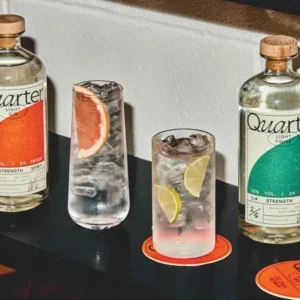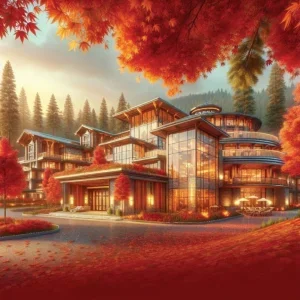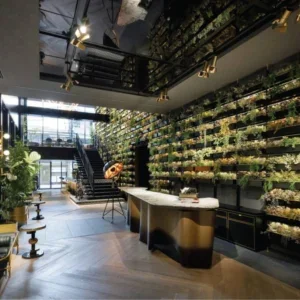If you asked Mauro Colagreco to trace the origin of his success, he might tell you it is down to the madness of youth. Opening his restaurant, Mirazur, in the south of France, he says, was done with the naivety of a 29-year-old chef, eager to launch his own restaurant but lacking the required experience and know-how.
He decided to open in a remote part of France where he didn’t know anyone, and no one knew him. “If I was to try it today,” he says. “I don’t think I’d do it. Everything was in place for the restaurant to close after six months.”
Having moved to France five years prior to the opening of Mirazur, the Argentine chef had trained with some of the most renowned chefs in the country – Bernard Loiseau, Alain Passard, Guy Martin and Alain Ducasse – but setting up for the first time in an area he scarcely knew proved a challenge.
“It was very difficult; I did not know any suppliers, I had no friends there and the building I took over had been shut down for four years,” he explains.
Yet you need a bit of good fortune in life and Colagreco says this saved Mirazur in the first years. He opened in April 2006 with two other people in the kitchen and one person front of house; in October that year, representatives from the Gault&Millau guide visited for the first time and named Mirazur newcomer of the year. Barely six months after, the Michelin Guide awarded him the first star.
The attention saw visitors coming from across France and beyond, but Colagreco says the struggle continued in the first few years. “We’d get coverage in The New York Times, but when I went to the local bakery in Menton, they’d say, ‘Mirazur? It’s closed, isn’t it?’” he laughs.
Those days of obscurity are firmly in the past. The second Michelin star came in 2012 and Mirazur was named fourth in the 2017 World’s 50 Best Restaurants. 2018 saw it rise to third and, at the beginning of 2019, Colagreco was awarded his third star, becoming the French edition’s first foreign-born chef – and the first Argentine worldwide – to receive the accolade.
He is recognised among a global generation of chefs who travel and work together. With that recognition has come global expansion into other countries. Over the past few years he has eased into the experience of operating in China. “The hardest thing is to understand the client, what they like, and then try to integrate,” he says. “Learning to work with local people and discovering local products are definitely the biggest challenges, but it is a wonderful market. The people love to eat, they appreciate food; I have learned so much in China about the cuisine, the techniques – it has enriched my cuisine.”
Colagreco’s cooking career was not a longheld dream nurtured since childhood, but something he fell into after falling out of love with his economics studies at university in La Plata, near Buenos Aires. “I grew up in an Italian- Argentine family, everything happened around the dining table and there was a lot of attention paid to food, but I never considered working in a kitchen,” he explains. Colagreco had already studied literature and soon realised economics was not going to be his path in life. He took a year out and headed to Buenos Aires where, as a means to earn some money, he got a job in the kitchen of a friend’s restaurant. It was love at first sight. “The first day in the kitchen was like an instant adrenaline shot,” he says.
Mirazur opens its doors, and Gault&Millau name the restaurant newcomer of the year.
He signed up to a course in cookery school and spent the next two years combining work and studies before deciding to leave for France. This was at the height of the Spanish gastronomy boom. Ferran Adrià was making waves with his avant-garde food at El Bulli and Spanish cuisine was receiving global attention. Why not go to Spain instead of France? At least he would be able to speak the language. He agrees, it would have been much easier.
The restaurant receives its first Michelin star.
“During those two years learning I met an older Argentine chef who inspired me to go to France,” he explains. “She took me under her wing, and she had travelled a lot to France, so I got curious and started studying the French and Spanish chefs at that time. What I realised was that even all the Spanish chefs had passed through France to learn.”
Don’t ask, don’t get
His mind made up, he enrolled at the Lycée Hôtelier de La Rochelle for a three-year course. It was a difficult time, but about to get even harder as the young chef went on his first work experience assignment. “We had to do a four-month stage after the first year, and I wanted to go to Bernard Loiseau’s restaurant, so I wrote them one, two, three, 10 letters asking for the place. At one point they wrote back and said, ‘Please, no more letters, we will let you know once we make a decision,’ but eventually I got the positive reply and I went.”
After five years and much hard work, a second Michelin star is awarded.
He found himself working in a restaurant in a small village in the middle of Burgundy with a population of just 3,000 and a huge kitchen brigade to fit in with. Colagreco, of course, was the only foreigner. “The experience taught me more than all the time learning in Argentina,” he says.
Chef Loiseau took to the young man and at the end of the four-month stint he asked him to stay and continue his learning at the restaurant rather than return to the cookery school in La Rochelle. Colagreco accepted the offer and quit school to work full-time in the kitchen.
Mirazur is named the world’s fourth best restaurant.
A tragic event that sent shockwaves through the industry saw him move on in 2003 when Loiseau took his own life. It was a heavy loss for Colagreco, who had built a strong relationship with his mentor. His death was surrounded by speculation of the pressure on Loiseau to maintain his three Michelin stars amid rumours that the guide was about to take one star away from him. The pressure had become too much, according to some.
The restaurant climbs a place to third.
For Colagreco it was a heartbreaking time that taught him much about working at the top of his profession. “I think Bernard had been so famous that he had almost constructed an image of himself, which covered up the person he really was, and even he had started to believe this image. Eventually, it all fell apart,” he says. “It was a great lesson for me to keep my feet on the ground, and be who I am regardless of success and recognition.”
Mirazur receives its third star.
He would go on to open his own restaurant as the fame of chefs rocketed, and has built his name amid the flashlights of a world hungry for new gastronomic trends. It is an opportunity he welcomes but he also believes it comes with responsibilities.
“It is not about being a fashion model; I think it is a great opportunity to pass on important messages – of passion, sacrifice and responsibility; of our commitment to nature – that is what I think we must do with this attention,” he says.
Reeling from the blow of losing such a strong influence on his career, Colagreco took off for Paris a month after Loiseau’s death. He had been offered a job at Alain Passard’s Arpege, but the opportunity was scuppered by world events – the Iraq War had kicked off and tourism numbers dwindled. Arpege would not, after all, need Colagreco. “There I was with the van packed and ready to make a new start after Bernard’s death and suddenly without a job.”
The situation in Paris calmed down, visitors returned and Arpege was ready for him. It would be one of the defining experiences of his career. Passard had eliminated meat from his menu and focused on vegetables. It was an exhilarating and enlightening time for him. “He had a totally revolutionary vision,” he says. “It was a big change mentally to view the kitchen from a different angle – he put his three Michelin stars on the table and said, ‘I’ll continue to do what I want to do’, and in that moment he wanted to cook with vegetables. It was a big risk.”
A few years later when he started to find his own style in the kitchen, Colagreco says it was Passard who influenced him the most. “You always create your own path and your own style, but I’d say that my cooking is closer to that of Passard than Alain Ducasse, for example,” he explains.
He describes his cooking as, “one of borders but without borders”, defined by the location between France and Italy, between the Mediterranean and the Alps “where the mountains drop into the sea. We are here in between two great gastronomic cultures that are very different,” he says. “In the middle, you have an Argentine chef, trained in France but who never wanted to make his cooking Argentine, French or Italian. My cooking is very personal.”
He prizes produce above all and for the past seven years has grown his own by the restaurant – the vegetables, he says, enjoy better views than the dining guests. “It is genuinely a place where a square metre of land costs a fortune, but it is in a zone where it is prohibited to build so we are very lucky.”
With reward comes challenge
Staffing is among the hardest parts of running the restaurant. The fact that there has been a proliferation of high-end restaurants in recent years and an increasingly global nature to the chef profession means that demand outstrips supply. Offering a quality experience for staff is imperative.
“We invest a lot in education and motivation, we have team-building sessions every month,” he says. “It is something that has changed a lot since I arrived here, but people travel more and they see what is on offer around the world, and they ask why they don’t get the same opportunities. Thankfully, man has evolved and we’ve learned to do things in a better way.”
If starting out in remote Menton 12 years ago was a difficult journey, Colagreco has certainly found his place now, and he has gone on to open restaurants in Asia, a brasserie in Paris and a chain of burger restaurants in Argentina. Is it necessary to open other projects in order to keep a high-end restaurant afloat?
“Mirazur is self-funded so it is not necessary now, but in the past we did need it. The first five years were difficult and we needed additional projects,” he says.
The sprawling group has given great opportunities for staff to travel the world while working in different restaurants. And it allows him to focus on Mirazur. “I can be present where I found my style and I can be part of the day-to-day here,” he says.
It is evident that the excitement and joy of the hands-on cooking experience in Mirazur remains. Illustrating this, he tells the story of asking his staff to cook a chicken dish for him – a new idea to try out. “To get the perfect and consistent result they prepared it for me with vacuum cooking, and as soon as I noticed I thought, ‘What are we doing here?’ I find joy in cooking a whole chicken to perfection, cutting it open and seeing the juices and flesh, controlling the temperature for the perfect result,” he says. “That is what makes me tick; not opening a bag and putting a piece of chicken on the plate. I want cooking to excite me.”
This article first appeared in FCSI’s Foodservice Consultant, www.fcsi.org.






